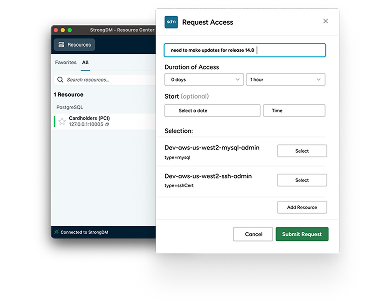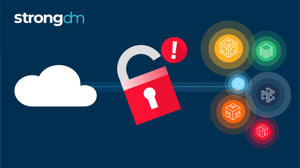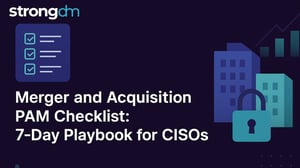StrongDM Debuts in Gartner’s Magic Quadrant for Privileged Access Management


Written by
Tim PrendergastLast updated on:
October 17, 2025Reading time:
Contents
Built for Security. Loved by Devs.
- Free Trial — No Credit Card Needed
- Full Access to All Features
- Trusted by the Fortune 100, early startups, and everyone in between
Gartner released its Magic Quadrant for Privileged Access Management (PAM) this week, and we’re proud and grateful to be part of it. Proud, because Gartner recognized us for the very innovations and principles we’ve built our platform around. Grateful, because the analysts took the time to truly understand what makes us unique in a market that’s rapidly evolving and, frankly, in need of evolution.
Gartner’s evaluation process is deep and deliberate. They perform a deep assessment of features and study a company’s vision, execution, customer experience, and innovation. In doing so, Gartner got to know StrongDM as a company reshaping what privileged access management means in modern, dynamic environments.
A Modern Approach in a Legacy-Weighted Market
The PAM Magic Quadrant still indexes heavily on traditional PAM capabilities. Vaulting, credential rotation, and session recording remain key evaluation pillars, and rightfully so. These are foundational controls that emerged in an era when privileged access primarily meant logging into a server or device with shared administrator credentials.
But the PAM market is in flux. Enterprises are now operating in cloud-native, DevOps-driven, and distributed environments where privileged activity doesn’t only occur through login sessions, it happens via APIs, ephemeral containers, CI/CD pipelines, and service-to-service communications. In these environments, access is often ephemeral, contextual, and highly automated. It’s no longer enough to secure passwords or record sessions; organizations need a way to govern who (or what) can do what, when, and under what conditions in real time.
While legacy PAM vendors have bolted cloud connectors or API integrations onto their vault-based systems, StrongDM was architected from the ground up as a universal access platform that treats authorization, not just authentication, as the primary control plane. Rather than managing access through static secrets, we enforce continuous, policy-based authorization that evaluates each request contextually, including user identity, role, device health, location, and resource type.
Through this architecture, we effectively provide universal access and authorization. It’s manifested in these ways:
- A single control plane that abstracts identity from infrastructure, granting temporary, least-privilege access to any resource type (databases, servers, clusters, cloud consoles, or APIs).
- Dynamic policy enforcement that governs access in real time, eliminating the need for pre-provisioned admin accounts or long-lived credentials.
- Granular activity-level auditing, enabling visibility not just into “who accessed what,” but “what they did while they were there.”
So while StrongDM protects secrets, our customers get more important value from our protection of actions. Our capabilities replace the static security boundaries of traditional PAM with adaptive, identity—and context-aware authorization that scales with modern infrastructures.
Where the Future is Headed
Industry recognition of our innovation and modern capabilities, from Just-in-Time (JIT) access to data-layer authorization, validates what our customers have known for years:
Privileged access today must evolve beyond static vaults, passwords, and long-lived credentials.
Modern environments are API-driven, ephemeral, and distributed across multiple clouds, clusters, and identities. Even for environments that have not fully undergone a digital transformation, privileged access no longer only flows through logins. It’s orchestrated through workload identities, service accounts, ephemeral containers, and automation pipelines. The next frontier for PAM will need to encompass authorization as a continuous process, one that unifies human and machine access across these hybrid contexts.
That’s the foundation we were built on. Our platform already delivers universal, policy-based authorization across any resource type, not just servers and databases, but Kubernetes clusters, CI/CD systems, cloud consoles, and beyond. Each access request is evaluated through a real-time authorization graph that maps users, roles, and resources across environments, ensuring that every action is verified, logged, and policy-compliant.
When Gartner’s frameworks inevitably evolve to measure these dimensions, including contextual authorization, machine identity management, and ephemeral access governance, then we believe StrongDM will continue to lead the way. Not because we’re chasing new category definitions, but because we’ve been building for where enterprise security has to go next:
- From static control to continuous verification
- From secrets management to action-level governance
- From PAM for people to PAM for everything
That’s the evolution that’s beginning to surface, and the one we’re already delivering
Universal Access on the Horizon
We’re grateful to Gartner for its thorough research and to our customers for their trust and feedback, which continue to shape every decision we make. Recognition like this reinforces that our focus on frictionless, policy-driven, and Zero Trust access isn’t just innovative; it’s necessary.
Gartner’s findings affirm that the future of PAM has evolved far beyond just managing credentials. It now must enable, at scale, secure access, anywhere, for anyone or anything, without slowing teams down. And, if you use StrongDM, it already does.
Next Steps
StrongDM unifies access management across databases, servers, clusters, and more—for IT, security, and DevOps teams.
- Learn how StrongDM works
- Book a personalized demo
- Start your free StrongDM trial

Categories:

About the Author
Tim Prendergast, Chief Executive Officer (CEO), before joining StrongDM, Tim founded Evident.io—the first real-time API-based cloud security platform. In 2018, Palo Alto Networks (PANW) acquired Evident.io, and Tim joined the executive team at PANW. As the first Chief Cloud Officer, Tim helped outline GTM and product strategy with the C-suite for the cloud business. Tim also served as the principal architect for Adobe's Cloud Team, designing and scaling elastic AWS infrastructure to spark digital transformation across the industry. Tim’s love for innovation drives his interest as an investor in true market disrupters. He enjoys mentoring startup founders and serving as an advisor.
You May Also Like




